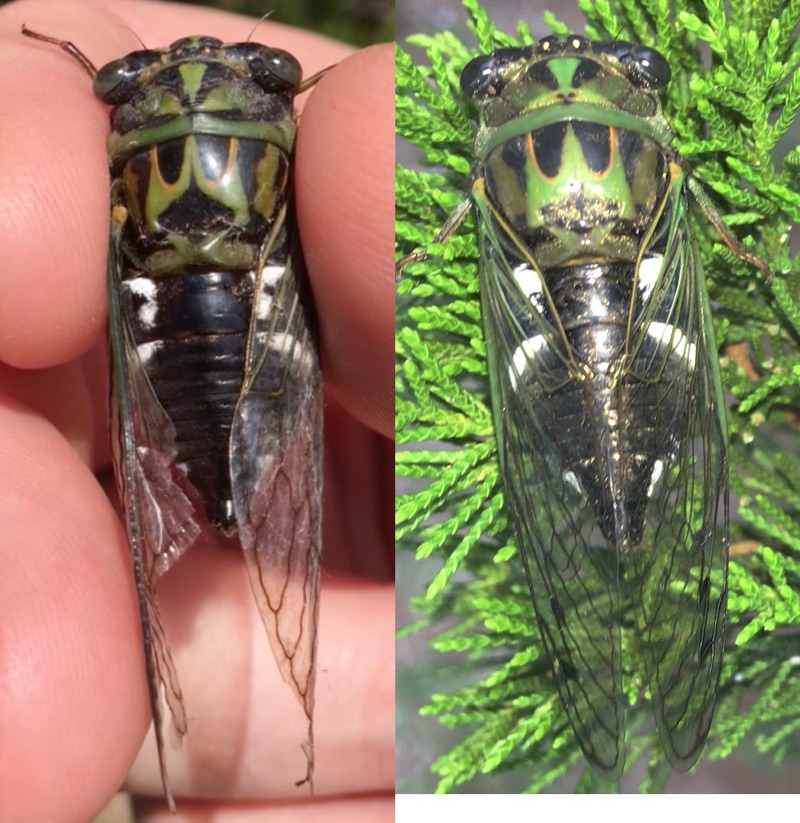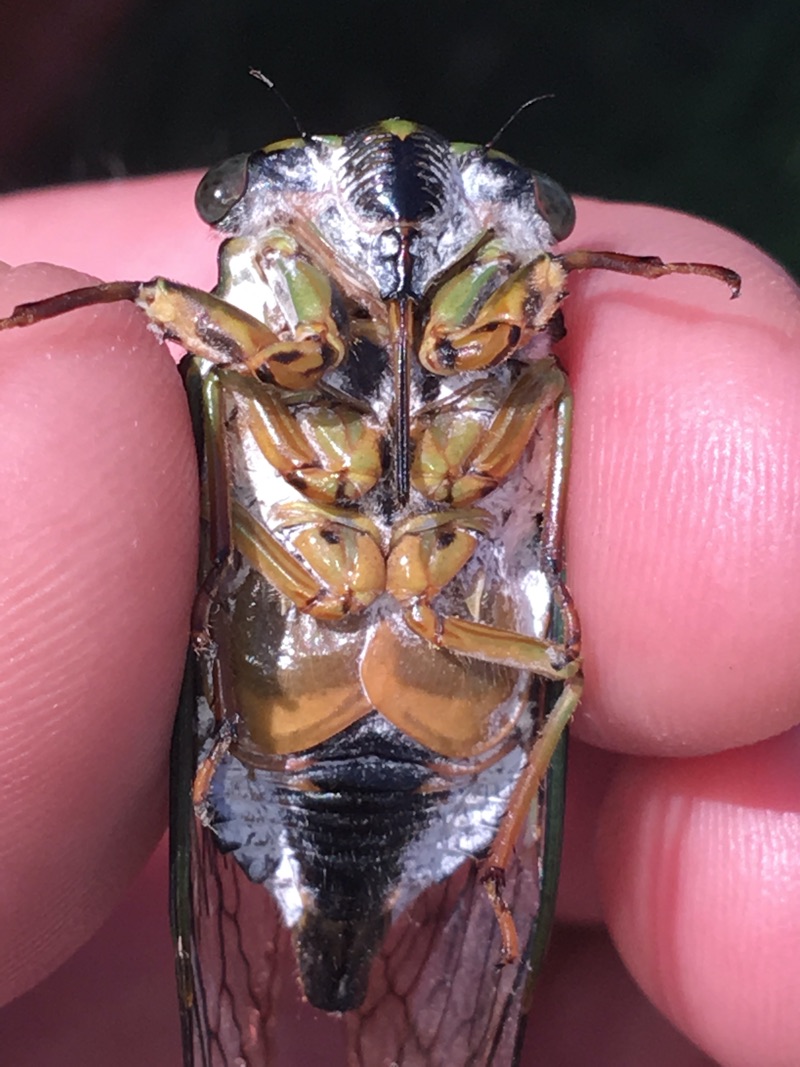This is a Neotibicen latifasciatus (Davis, 1915) commonly known as the Coastal Scissor Grinder, locally known as a Yodeling Cedar Sucker in Florida and Beach Banshee in North Carolina 3:

The holotype — a single type specimen on which the description of a new species is based — for the cicada Neotibicen latifasciatus was gathered from Cold Spring, Cape May County1. I feel that N. latifasciatus needs a common name indicative of Cape May, New Jersey. Here are my ideas:
- Cape May Crooner
- Cape May Crier
- Cape May Car Alarm
- Shore Shrieker
- Woodbine Warbler
- South Jersey Shore Screamer
The last one is my favorite (changed it to South ;))
N. latifasciatus is a cicada found along the east coast of the United States, and is known for its preference for cedar trees. It can be found in New Jersey, Maryland, North Carolina, Virginia2, Florida and points in between3. Its affinity for cedar trees (plus its distinct call) makes it relatively easy to locate and capture — if you’re willing to get a little messy climbing through the thick & sticky branches of a cedar tree. A thin mist of sap from the cedar seems to coat the wings of these cicadas, and it’s worth mentioning that their wings are often torn and ragged, probably resulting from the thick cedar foliage.
When William T. Davis first described N. latifasciatus in 19154, he described it as a variety of Cicada pruinosa (now Neotibicen pruinosus pruinosus). This is understandable, since they sound very much alike, and look alike except for the the white bands on the sides of the latifasciatus, some other minor morphological differences, and habitats. pruinosus, latifasciatus, winnemanna, linnei, canicularis, and robinsonianus are collectively known as the Green [Neo]tibicen Species3 or simply “the Green Group”.They’re called Green because much of their heads, collars, pronotums and mesonotums are green in color.
On Saturday, August 20th, 2016, I met Elias Bonaros and Annette DeGiovine-Oliveira in Middle Township, Cape May County to search for latifasciatus. I arrived before they did and located a relatively quiet road lined with cedar trees, filled with screaming latifasciatus. From the outside cedars resemble twisting green fire; on the inside they’re a mess of tightly-packed, dirty branches — perfect for an insect to hide. The road and trees were surrounded by briny marshland, less than a mile from the Atlantic Ocean. Other than cicadas, there were an abundance of annoying greenhead flies (Tabanus nigrovittatus), and not annoying at all katydids. The temperature was in the mid 80s, the air was humid, the sun was brutal, and the flies thought I was delicious. In the 5 hours we spent photographing and gathering specimens, I drank a gallon of water. Elias handled cicada procurement duties, and Annette and I recorded the cicadas’ song and habitat.
Here’s a video summary of our adventure:
After a satisfying lunch, I went looking for other locations and found a very different but prime in-land location with taller cedar (Red and White varieties) in Woodbine Borough. There we found many exuvia, which we did not find at the other location, and heard not only latifasciatus, but also N. linnei, N. tibicen tibicen, N. canicularis, and N. auletes. Around 9pm, and almost 12 hours of cicada field-work, I called it quits. Elias and Annette stuck around and were able to observe molting latifasciatus.
The ventral side a male Neotibicen latifasciatus:

This cicada was captured using the “clap” method of netting cicadas. This method involves two people using two nets, surrounding the cicada so it can’t find an escape path.
I would be remiss if I did not mention how delightful the people of Cape May County are. All the folks we encountered were pleasantly curious or encouraging about our cicada research activities. They also have “Custard” shops instead of Ice Cream shops.
Also check out Annette’s YouTube channel for video of the latifasciatus habitat and song.
1 Sanborn AF, Phillips PK. 2013. Biogeography of the Cicadas (Hemiptera: Cicadidae) of North America, North of Mexico. Diversity 2013, 5, 166-239.
2 Sanborn AF, Heath MS. 2012. The Cicadas (Hemipetera: Cicadoidea: Cicadidae) of North America North of Mexico. Entomological Society of America. 45.
3 BugGuide Species Neotibicen latifasciatus page.
4 Davis WT. 1915a. Notes on some cicadas from the eastern and central United States with a description of a new variety of Cicada pruinosa. Journal of the New York Entomological Society 23: 1—10. (see the North American Cicadas page)
4 replies on “Neotibicen latifasciatus – the South Jersey Shore Screamer”
Forgot to mention that I am in West Deptford, NJ.
Feel free to email me at cicadamania@gmail.com
I have found at least three of these in my backyard. I wish I could post it.
Beautiful coloring and bright green wings. I’ve been moving them when I see them on the ground so as not to step on them or let my dogs bother them.
Fwiw, those of us from the far south of NJ refer to the region as “South Jersey”.